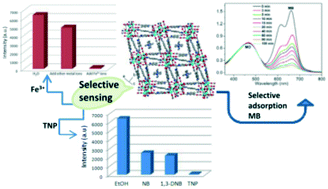A stable anionic metal–organic framework with open coordinated sites: selective separation toward cationic dyes and sensing properties†
Abstract
A novel metal–organic framework, [H2bpy]0.5[Cd3(OH)(L)2(bpy)(H2O)2]·(bpy)0.5·2H2O (1) (H3L = 3-(3,5-dicarboxylphenyl)-4-carboxylpyridine, bpy = 4,4′-bipyridine), with blue luminescence, was successfully synthesized under solvothermal conditions. Structure analysis indicates that this compound is composed of triangle [Cd3(μ3-OH)] clusters linked by L ligands, forming a novel 3D framework with a (3,3,8)-connected (42·6)(42·6)(44·55·64·78·87) topology. Cd-MOF-1 contains microporous channels with accessible Lewis-base sites (N), uncoordinated carboxylate groups and coordinated H2O molecules, which are easy to recognize various small molecules. Meanwhile, this compound exhibits a microporous structure with [H2bpy]2+ cations being located in the channels, which can be easily replaced by some cationic dyes. Particularly, Cd-MOF-1 displays high water and pH stability. Based on the aforementioned considerations, when Cd-MOF-1 was immersed in the different metal ion aqueous solutions and different nitro explosive EtOH solutions, it performed as a highly selective and sensitive sensor for Fe3+ ions and TNP (2,4,6-trinitrophenol). Moreover, the probable sensing mechanism was also investigated in detail. More interestingly, dye adsorption studies revealed that Cd-MOF-1 can adsorb cationic dyes in aqueous solution while the anionic and neutral dyes cannot be absorbed and the cationic dye adsorption amounts decrease with the increase in dye size. Therefore, Cd-MOF-1 can potentially act as a column-chromatographic filter for the separation of dye molecules.

- This article is part of the themed collection: Editor’s collection: Chromism in Frameworks


 Please wait while we load your content...
Please wait while we load your content...